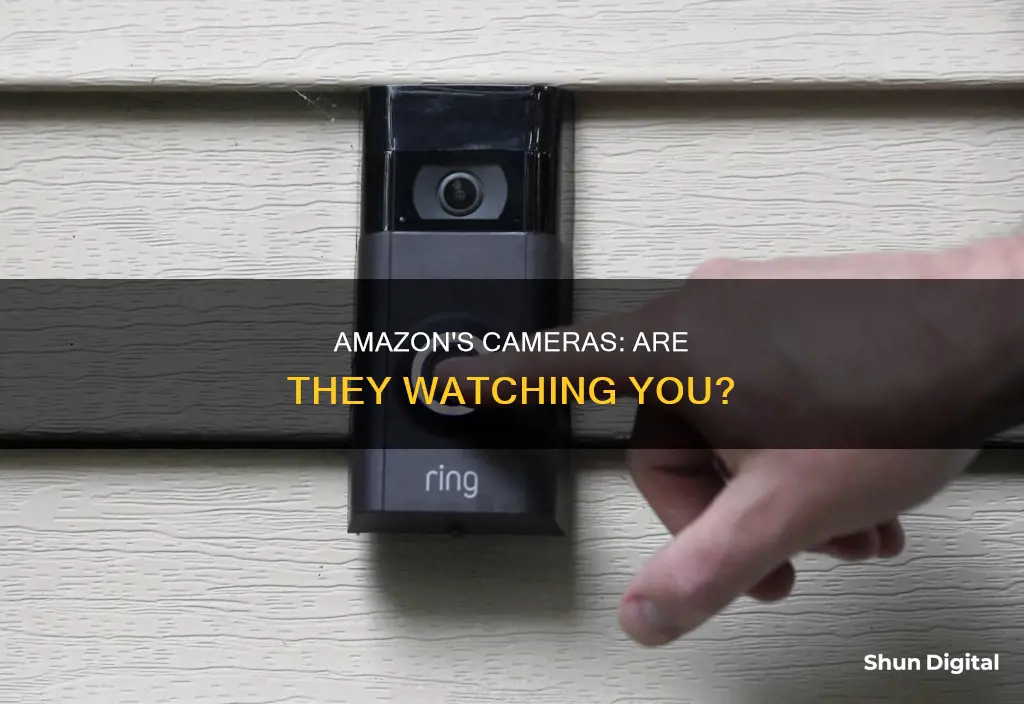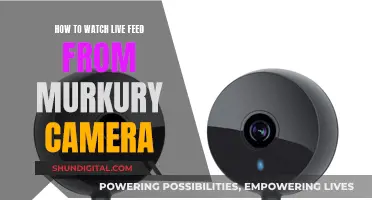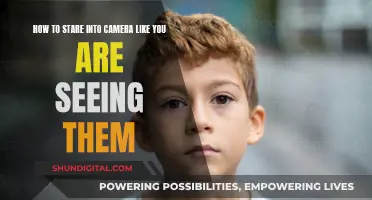
Amazon has been criticised for its invasive employee monitoring, which includes AI cameras and even hiring a spy agency. The company has also been accused of fostering a culture of surveillance in the workplace. While Amazon claims that these measures are necessary for safety and efficiency, some workers feel that they are being unfairly punished and that the system lacks transparency.
Amazon's use of AI cameras extends beyond their warehouses and delivery vehicles, as they also sell home security cameras that are marketed as a way to monitor your home, day or night. However, it has been revealed that these cameras are reviewed by human employees, raising concerns about privacy and data security.
So, does Amazon watch you through their cameras? The answer appears to be a qualified yes. While Amazon's primary goal may not be to spy on its customers or employees, they do have access to and utilise footage from various cameras for different purposes.
| Characteristics | Values |
|---|---|
| Who can access the camera feed? | The owner of the camera, people with the passcode, Amazon, the government |
| Camera quality | 1080p or better |
| Amazon's use of camera footage | Training AI algorithms, monitoring drivers |
What You'll Learn
- Amazon employees can access your Cloud Cam footage
- Amazon uses AI cameras to monitor its employees
- Amazon has been accused of union-busting by tracking pro-union sentiment
- Amazon drivers are monitored by cameras with biometric feedback indicators
- Amazon warehouse workers are tracked by a time off task system

Amazon employees can access your Cloud Cam footage
Amazon has dozens of workers reviewing clips recorded by its Cloud Cam security camera, according to a report from Bloomberg. The report states that Amazon workers based in India and Romania review select clips captured by Cloud Cam. These video snippets are then used to train the AI algorithms to better distinguish between a real threat and a false alarm.
An Amazon spokeswoman said that the company only reviews clips that are submitted by Cloud Cam owners for troubleshooting purposes, as well as those from employee testers. However, two sources stated that footage submitted for review sometimes included private interactions, such as recordings of sexual activity.
Amazon has imposed tight security on the Cloud Cam annotation operation. In India, dozens of reviewers work on a restricted floor, where employees are not allowed to use their mobile phones. Despite these measures, there have been instances of Amazon employees passing footage to non-team members.
While Amazon states that it takes privacy seriously and gives Cloud Cam customers control over their video clips, the company's terms of service agreement for the Cloud Cam do not explicitly mention that Amazon workers may view footage recorded by the camera. It does, however, state that the customer grants Amazon permission to "review your Cloud Cam recordings to provide technical support."
This discovery has raised concerns about privacy, especially since Amazon had previously come under scrutiny for a separate report revealing that Amazon contractors manually annotate Alexa recordings, allowing them to listen in on private conversations. In response, Amazon introduced new privacy features, such as a voice command that allows users to erase recordings from their Echo devices.
School Bus Camera Footage: Who's Watching?
You may want to see also

Amazon uses AI cameras to monitor its employees
Amazon has been under fire for its workplace practices, with workers reporting a feeling of being watched by their employer. The company uses several methods to monitor its employees, including AI cameras.
For delivery drivers, Amazon has introduced the Netradyne Driveri system, which features a four-part camera with biometric feedback indicators. This system monitors drivers' eye movements, speed, and even yawns, sending a live feed of the recording to managers. The practice has been deemed invasive, with at least one driver quitting in protest.
In warehouses, Amazon tracks workers' "time off task," or the amount of time they are not directly working, using AI-powered cameras. This system has been criticised for its lack of transparency and potential for unfair punishment, with managers able to edit time off task data.
Additionally, Amazon has been known to use distance assistants in warehouses, where green circles surround workers on a screen if they maintain a six-foot distance. If workers get too close, the circles turn red.
Amazon also uses AI cameras to monitor social distancing among Whole Foods employees, creating "unionization heat maps" that track various factors indicating pro-union sentiment, such as the distance to a union office and the number of HR complaints.
While Amazon claims that these measures are to ensure safety and improve efficiency, the use of AI cameras to monitor employees has sparked concerns about privacy and the potential for unfair treatment or punishment.
Feisty Pets and Cameras: Are They Watching You?
You may want to see also

Amazon has been accused of union-busting by tracking pro-union sentiment
In 2021, Amazon was compelled to post a "notice to employees" in the break room of a warehouse in Virginia, listing 22 forms of behaviour that the company would disavow in relation to union activities. This included promises not to threaten employees with the loss of their job, interrogate them about the union, or engage in surveillance of union activities.
However, despite this notice, Amazon has continued to face accusations of union-busting and unfair labour practices. In April 2024, workers at Amazon's ONT8 fulfillment center in Moreno Valley, California, claimed that the company used scare tactics and spread misconceptions to halt their union drive. Nannette Plascencia, an employee at ONT8, described how Amazon summoned employees to "'protect your privacy' meetings, where external anti-union consultants warned workers about the potential negative consequences of unionizing. Plascencia also stated that managers regularly interrogated workers about their union support and that Amazon's messaging disrupted their union organizing efforts.
Similar complaints have been made by workers at other Amazon warehouses in Albany, New York; Bessemer, Alabama; and Kentucky. In May 2024, Unifor, a union in British Columbia, filed an unfair labour practice complaint against Amazon, alleging that the company ramped up hiring at a Delta, B.C. warehouse to dilute union support. Unifor's western regional director, Gavin McGarrigle, stated that the scale of Amazon's alleged anti-union efforts was beyond anything he had experienced with other employers.
In response to these accusations, Amazon has denied any wrongdoing and claimed that its employees have always had the choice of whether or not to join a union. The company also stated that it already offers competitive pay, health benefits, and opportunities for career growth, which are often requested by unions.
Android Smartwatches: Camera-Equipped or Not?
You may want to see also

Amazon drivers are monitored by cameras with biometric feedback indicators
Amazon has long been known for its use of technology to monitor its workers' activity in the name of efficiency. In March 2021, the company began rolling out AI-powered cameras in its delivery vans, requiring drivers to consent to be monitored or lose their jobs.
The Netradyne-made cameras record "100% of the time" and collect a range of data, including vehicle location, speed, acceleration, braking, turns, and following distance, and potential traffic violations. They also use biometric indicators to monitor drivers' facial and body movements, tracking signs of distraction, drowsiness, and whether the driver is wearing a seatbelt.
The system provides real-time feedback, alerting drivers to take a break or keep their eyes on the road. Amazon has defended the use of these cameras as a safety measure, stating that they are intended to improve driver and community safety. During a pilot program, accidents decreased by 48%, stop sign violations by 20%, driving without a seatbelt by 60%, and distracted driving by 45%.
However, the implementation of these cameras has sparked controversy and privacy concerns among drivers. Some have criticised the level of micromanagement and the potential for the AI systems to make mistakes. Additionally, senators have raised concerns about drivers' privacy and the possibility that the surveillance could create pressure on drivers to speed up, leading to increased fatigue and decreased safety.
Employee Surveillance: Is It Legal to Watch Your Workers?
You may want to see also

Amazon warehouse workers are tracked by a time off task system
Amazon's demanding culture of worker productivity has been revealed in multiple investigations. The company employs a system that not only tracks warehouse workers' productivity but also can automatically generate the paperwork to fire them for failing to meet expectations.
Amazon's system tracks a metric called "time off task", which measures how much time workers pause or take breaks. If an employee takes a break from scanning packages for too long, the system automatically generates warnings and, eventually, the employee can be fired, all without a supervisor's intervention. However, Amazon stated that a human supervisor can override the system.
The time off task policy has made working conditions more strenuous, and it's used as a tool to surveil workers. Amazon workers have, at times, pushed back against the company's productivity requirements, with East African immigrant workers at a Minnesota facility organizing protests, saying they didn't have sufficient break time, including for prayer.
Amazon's mechanisms for exacting productivity are pervasive in many areas of its operations. For instance, drivers delivering Amazon packages have reported feeling so pressured that they speed through neighborhoods, blow by stop signs, and pee in bottles in the trucks or outside.
The company's focus on speed and surveillance has led to higher warehouse worker injuries, with nearly 70% of Amazon employees in a survey saying they've had to take unpaid time off due to pain or exhaustion suffered on the job in the past month, while 34% have had to do so three or more times.
Streaming Sites to Watch 5 Broken Cameras Documentary
You may want to see also
Frequently asked questions
Amazon has been known to monitor its employees through AI cameras and by hiring spy agencies. Amazon delivery vans are equipped with a four-part camera with biometric feedback indicators that monitor if drivers look away from the road, speed, or yawn. The footage is sent to managers and can be used to train AI algorithms.
Amazon Cloud Cam home security cameras are equipped with AI technology and can be accessed by Amazon workers in India and Romania. These workers review select clips captured by Cloud Cam to train the AI algorithms to distinguish between a real threat and a false alarm.
It is recommended to keep video content recorded in a local format instead of using cloud services. Additionally, you can cover your camera with tape or place it in a power strip with a physical on/off button to cut its power when not in use.
Yes, you can share your camera footage with others through the app by using a passcode. This allows family or friends to view the footage remotely.
Amazon has access to your camera footage and can share it with government agencies if required. It is important to note that any security camera system you use may be accessible to the company and the government.







